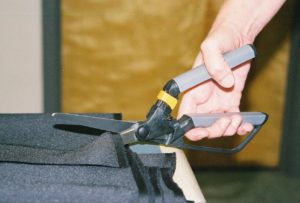
Painful joints in your hand(s) can slow down how you function during the day. You may even be taking medication to control that pain. We would like to show you some joint protection techniques- this is one way to help decrease the pain, plus help protect your joints for the future. So what is joint protection? Joint protection is a simple way to change how you complete a normal activity to avoid putting stress and strain on the joints, causing less pain. Occupational Therapists (OT) have been teaching joint protection for over 20 years, by putting less force on the small joints in the hand; this can not only lead to pain relief, but also create less “wear and tear” on the joint. The next time you do an activity that results in pain to your hands, stop for a minute, and try to figure out what is causing the pain and what you can modify to make the activity less painful.
Here are some simple suggestions for changes to make to decrease the pain in your hand. This does not have to cost a lot of money. A little creativity can do the trick once you know what causes your pain. Many people complain of pain while writing, pinching, turning the key in the car, and can usually isolate the pain to the base of the thumb. One reason for this discomfort, for every 1 pound you pinch at the thumb tip, it delivers 12 pounds of force to the base of the thumb.
Most of the time the best way to modify your activity involves the slogan: “Bigger is Better”. The larger the pen, handle, key, utensil etc. the less force you apply to the joints in your hand. Regarding pens or pencils, especially if you write a lot, buy a bigger/wider pen, use a pen grip, or make your own using foam or soft tape. Below are some examples:


Using spring loaded scissors take a lot of pressure off the base of the thumb, for those who use scissors consistently, most fabric stores carry this type of scissors. No matter what your “tool of trade” is you can always make the handle bigger for paintbrushes, on your tooth brush, any handle that is difficult or painful to grip. When opening jars, use your palm to turn the lid instead of your finger and thumb.


Believe it or not some simple ideas for gadgets can also help ease the pain to your hands. Again think of the things around the house, kitchen in particular, that causes increase pain. Here are a few solutions to some common problems causing pain to the hand(s). These gadgets can be found from kitchen stores, to dollar stores, and medical companies specializing in adaptive equipment. Sometimes just knowing what to look for is half the battle. Again, sometimes you can use foam or tape to build up handles on your favorite tools.
- Use an electric can opener, or at least a manual can opener with big handles (especially the handle you turn).
- A wide variety of jar openers are available, some can even attach under the cabinet. If not you should at least use a non-skid rubber surface to open all jars so you apply less force with your hands.
- Paring knives, regular utensils, potato peelers all come with extra wide firm handles – they are also dishwasher safe.
- Big plastic spoons, spatulas, tongs are made with wide handles.
- Apple slicers, ice cream scoopers, pizza slicers, garlic press all come with easy to grip handles allowing use of your arm versus the small joints of your fingers.
Hopefully this has given you some ideas to modify the tasks that are painful to your hand(s). Occupational Therapists in particular Certified Hand Therapists (CHT) are your best resource for any injury or condition to your hand or upper extremity. A CHT works with patients with a variety of upper extremity disorders, including but not limited to tendon/nerve disorders & lacerations, fractures, inflammatory disorders, and nerve compressions. Many patients seeking the care of a hand therapist also suffer from such chronic problems as arthritis or neurological conditions. A hand therapist works closely with the physician to provide a continuum of care for patients.
This article was written by Kingwood Occupational and Physical Therapy in the Houston, Kingwood area. More information about the physical therapy Kingwood location can be found at www.kingwoodotpt.com

